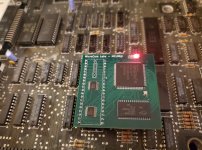Hi,
I have another update on the project:
https://microcorelabs.wordpress.com/2020/11/10/mcl86jr-worlds-fastest-pcjr/
When the board is running with the CPU in "unlocked" mode (not slowed to be cycle accurate) and using the fast SRAM controller, it appears to allow the PCjr to run 4X faster than an IBM PC/XT and as fast as an IBM PC/AT.
There are a few PCjr related issues which I am trying to understand, but the MCL86jr board seems to work great! I don't have a lot of mileage on it yet, but the results so far look good.
Some of the quirks are that Cartridge BASiC does not work, nor do some of the ctrl-alt-ins PCjr build-in tests. I also noticed that Norton's SI sometimes says it is an Intel 8088, and sometimes a NEC V20; so my initial guess is that there are loops in the software timing which rely on the exact PCjr hardware and CPU. Aside from this all of the other software I have tried works great. Things like King's Quest, Archon, Flight Simulator, multiple DOS versions, and more. I have more stuff to try, but so far most professional software seems to run fine.
Currently I am entering "unlocked" mode as soon as a key is pressed (Im looking at an NMI), but need to add some snoop registers to enable/disable things like cycle accuracy and the fast SRAM controller. I will probably use write accesses to the BIOS ROM at F0000.
I tried changing the computer-ID from 0xFD to 0xFF but DOS 3.2 doesn't like it! DOS 2.1 works fine and when running SI.EXE it shows up as an IBM PC. As soon as DOS 3.2 gets to the A> prompt and I press a key a bell sounds and the system locks up! I can make the computer-ID changeable under register contriol, but if some DOS's refuse to work then it might not be worth it...
Thanks,
-Ted

